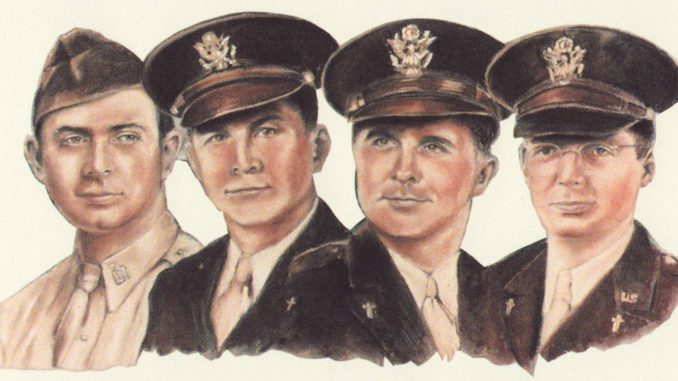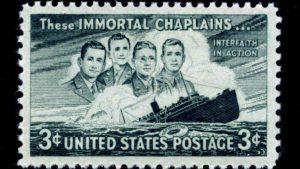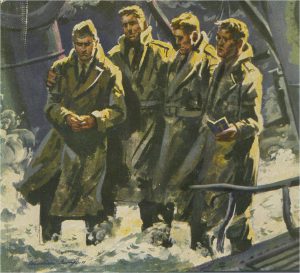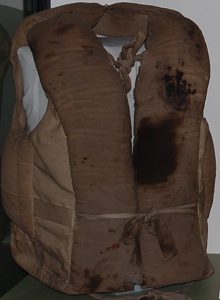
Remembering The Four Chaplains
Remembering the Four Chaplains: The U.S. Army transfer ship, the Dorchester, was loaded with 751 new soldiers, mostly teens and young adults, heading off to serve in World War II. It was February 2, 1943 when they boarded and were joined by the crew, some civilian workers and four chaplains, the onboard count was 900 people, crammed tightly onto the ship. The ship sailed from Boston Harbor with a destination of Greenland. The seas were rough and most spent their time feeling sick as they tried to sleep below deck.
On February 3rd, a German submarine targeted the heavily laden ship and three torpedoes struck it, immediately killing many and sending the young passengers into a spiral of fear and chaos. Life boats were lost in the explosion and pitching of the ship and desperate passengers clamored to overload the remaining lifeboats. The Dorchester was taking water fast and the captain was forced to order all to abandon ship.
The eye witness recounts of what transpired on that icy day capture the efforts of heroes and remembering their story paints a picture of America and also the face of the faiths of the four chaplains on board that fateful trip.
Eye Witness Recounts

In the chaos and confusion, one chaplain stopped a man trying to return to his cabin for gloves and gave the soldier his own pair, claiming he had a second pair when he did not. The chaplain’s urgent plea for the man to get to a lifeboat saved his life.
As the young soldiers shouted for help or cried in dismay becoming disoriented by the cold and fear, the four chaplains were the voices they heard, as they directed the young men to remaining life boats, handed out life vests, and provided words of calm and courage in the face of danger. The chaplains, despite each being of different faiths, were a visual cue for courage for the soldiers, who saw the four link arms and begin to openly pray for their fellow soldiers and for courage as they faced insurmountable odds.
Sacrifice
Finally, when it was clear that there weren’t enough life vests for everyone, the four chaplains gave up their own life vests and handed them to young soldiers, who would live to recount the acts of selfless heroism they witnessed.
As the elders among the passengers, these ministers of faith were also young…
Father John Washington
John P. Washington, the 34 year old son of poor Irish immigrants, was a Roman Catholic priest ordained in 1935 and his first parish was in Elizabeth, New Jersey. After the attack at Pearl Harbor, John enlisted to serve, but was quickly directed to service as a chaplain. In November 1942, he reported to Camp Myles Standish in Taunton, Massachusetts and met Chaplains Fox, Goode and Poling at Chaplains School at Harvard.
Rabbi Alexander Goode
Alexander Goode was a 31 year old rabbi with a Jewish congregation in Washington, D.C. While tending to his duties as a rabbi, he completed a medical degree at John Hopkins University. With the start of World War II, he also headed to Harvard for chaplaincy studies with Washington, Fox and Poling.
Chaplain Clark Poling
The son of Army Chaplain, Daniel Poling (World War I), 32 year old, Clark V. Poling of Columbus Ohio followed his father’s footsteps, but he chose the Reformed Church in America. He eventually became the pastor of the First Reformed Church in Schenectady, New York, when the outbreak of WWII occurred and he signed an Army chaplain and also headed for Harvard for chaplaincy studies.
Minister George Fox
At the age of 42, George L. Fox was the older of the passengers on the Dorchester. George had served as a Marine in World War I, only being able to enlist because he lied about his age to be able to enlist. As a marine, he was decorated with the Croix de Guerre, Purple Heart, and Silver Star for his acts of bravery. After the war, he worked as a public account following studies at Moody Institute, but eventually determined he was meant to be a minister and studied at Boston’s School of Theology. He served at Methodist churches and then administered at hospitals as the Chaplain for the State of Vermont. With the start of WWII, he was called to the army and his wife agreed he would be needed and he also headed to Harvard.
Four Friends
It was at Harvard that these four met and began their friendship and then found themselves together on the Dorchester with its crew and hundreds of young servicemen.

More than 600 men died in the icy waters near Greenland, but thanks to rescues from nearby ships and the acts of the Four Chaplains, 230 men survived and lived to tell of the acts of these four men.
In 1948, a postage stamp was dedicated to the Four Chaplains as a way of honoring their interfaith unity and heroic acts. It is pictured in this article.
Remembering and Honoring
In the late 1940’s, a relative of one of the chaplains began an effort to keep the story of The Four Chaplains alive as an effort to foster interfaith unity and to honor acts of heroism. In1951, the Chapel of the Four Chaplains was dedicated and that chapel and The Four Chaplains Foundation has been telling the story of the Four Chaplains and encouraging selfless sacrifice and interfaith cooperation. On February 15, 2001, the Chapel of the Four Chaplains moved to 1201 Constitution Avenue, Philadelphia, PA 19112 the site of a World War II Navy Chapel.

In his chapel dedication speech, the President Harry S. Truman said, “This interfaith shrine… will stand through long generations to teach Americans that as men can die heroically as brothers so should they live together in mutual faith and goodwill.”
Memorials and Awards
In addition to the Chapel, there are eleven (11) other memorials to The Four Chaplains in the United States and, in many communities, services to commemorate the unifying spirit of these four men are celebrated on February 3rd.
The Distinguished Service Cross and Purple Heart were awarded posthumously December 19, 1944 to the Four Chaplains with their next of kin accepting for them. Because the chaplains were not eligible for the Medal of Honor (There is a requirement that recipients had to be under fire during their acts of heroism.), a one-time only posthumous Special Medal for Heroism was authorized by Congress and awarded by the President Eisenhower on January 18, 1961.
Forever in History
The Four Chaplains went down with the USAT Dorchester that day, but their story of unity, selflessness, courage and faith lives on with each recount of their heroism.
Sources:
http://www.cnn.com/2013/02/03/opinion/greene-four-chaplains/ http://www.fourchaplains.org/the-saga-of-the-four-chaplains/ http://www.fourchaplains.org


Leave a Reply